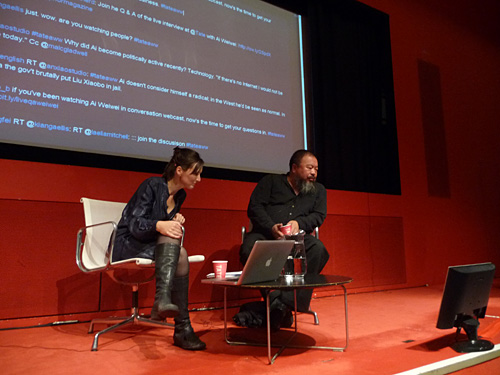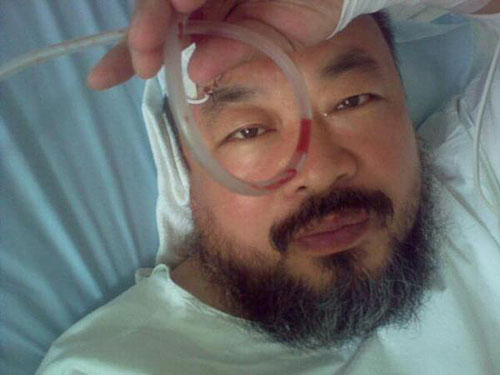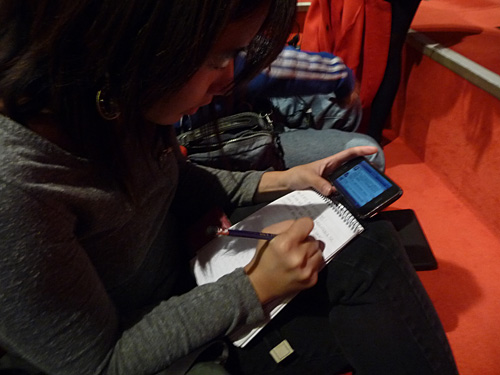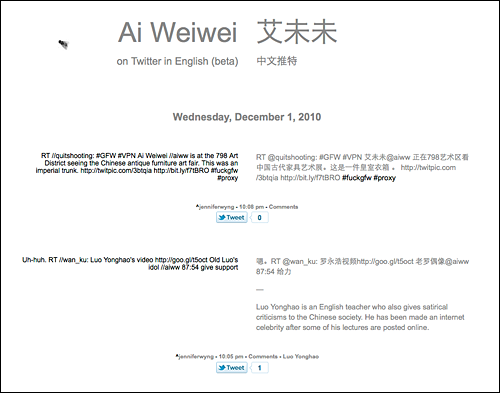
Artist Ai Weiwei in conversation with Tate Modern curator Katie Hill, October 2010. Photo by An Xiao.
This past summer, Jennifer Ng and I launched Bird’s Nest: Ai Weiwei in English. Mr. Ai, artist and a vocal critic of the Chinese government, enjoys a following of more than 50,000 on Twitter.
He is the second most-followed contemporary artist on Twitter after Yoko Ono and in my opinion, he engages his audiences in some of the most compelling and engaging social media art projects. However, to English-speaking audiences, by the far the dominant group on Twitter, his tweets fly past with not even a sense to how to pronounce them.
As the site name suggests, Bird’s Nest relies on a team of translators and contributors to translate and bring context to the tweets of artist Ai Weiwei. Since the beginning, Jennifer and I have relied on split management: while I worked on the operations, functionality, and design of the site, Jennifer managed the language and culture posts.
The nature of the Chinese language, whose words take up only 1–2 characters on screen, mean that Chinese-language tweets can be as long as a paragraph. Thus, we opted for Tumblr, which preserves the real-time and social nature of Twitter while allowing greater flexibility in translation and contextualization. I worked with our anonymous designer to develop a two-column format ideally suited for translation, and I work to ensure the site’s operations are running smoothly while contributing my own translations and working with Jennifer to determine the overall direction of the site.
As our editor, Jennifer has been closely involved in the almost all the tweets that Mr. Ai sends out. She is uniquely suited for the job, as a freelance translator and native speaker of both languages; active user of social media and proponent of social media art; and coordinator of the Master of Communications Sciences in Technology-Enhanced Communications for Cultural Heritage at the University of Lugano, with a background in semiotics and museum studies. Her dedication to accuracy has ensured the highest quality of translations, and our site has now been cited in The Wall Street Journal, CNNGo, Shanghaiist, and others. She was also asked recently to contribute translations for Mr. Ai’s current installation the Tate Modern.
I sat down with Jennifer over Skype to talk about how Ai Weiwei uses Twitter, and some of the challenges of translation. I also spoke separately with one of our translators, André Holthe, a Chinese scholar and industrial economist based in Norway and editor of Faces of China; I’ve blended in his responses here as appropriate.
An Xiao: When did you start following @aiww?
Jennifer Ng: It must have been about less than a year before we started translating his tweets. I think it was before or after his injury in Germany that I realized he actually has a Twitter account. I have continued to pay attention to his tweets since then for two reasons. One, because his tweets can be funny and inspiring at the same time. Two, because his tweets appear on the screen a lot. At his peak, I believe he posted hundreds of tweets a day.

Ai Weiwei in the hospital, September 2009 (via the artist’s Twitpic account)
AX: What got you interested in translating?
JN: I’ve been a freelance translator for about two years now. Mr. Ai tweets only in Chinese, and the idea that it could be interesting translation material popped up now and then in my head. This is a time that Mr. Ai has been quickly garnering attention from the Western world, and it would have been very useful for a broader, English-speaking audience to understand what his tweets are all about. His messages of social change, his critique of the Chinese society, his latest art projects, and his wonderful sense of humor all deserve a greater audience. When you asked to work with me on the aiwwenglish project, it really synced with what was going on in my head. I was really glad you asked, and of course I jumped on the idea.
André Holthe: I decided to join as a translator for two main reasons: First of all I thought the idea of translating Ai’s tweets was a brilliant one. Not only does his work and thereby his tweets touch upon a wide range of topics (art, social injustice, activism etc.), but it carries a certain prosaic quality. So translating his tweets seemed to me like a great thing to do, a challenge, but a rewarding one. Second, I had been translating Chinese media for quite some time, and I felt I was putting in more work than I actually had time for. At the same time, the op-eds and wha not I translated did, obviously, have a limited audience. So, to join as a translator was also a way for me to put in less time, but with equal reward (both in terms of personal gain and in terms of a broader audience).
AX: What’s it like being an editor? We’ve grown the site quite a bit since our launch, when it was just you and me. Now we have four active translators and three contributors around the world.
JN: It has been a wonderful experience to be the editor of aiwwenglish. I get to work with a very international team of translators and contributors, we share the same interests on Mr. Ai and his work, and being the editor of the project has really opened my eyes to the various conversations surrounding Mr. Ai’s life, his art, and most importantly, his issues of concern about the Chinese society.
I have to say that all our contributors are very knowledgeable about the Chinese and English languages and/or the cultural issues that are at play, so rather than doing any heavy editing, I’d say I’m more the person who works on maintaining a certain level of consistency for the project. For instance, with slang terms, names, pinyin formats, I try to keep them translated into consistent English terms, so the audience could get used to the references more easily.
Right now my approach is to make the translations as close to real time as possible. Previously I have just been translating the Chinese tweets in a chronological order. Turns out it doesn’t really work well because he tweets so much. Every time when you’re trying to backtrack and find where you left off, you’re already very far behind from his latest tweets and they don’t seem relevant to what’s going on on Twitter anymore.
Now I’m using reverse chronological order. I scan the latest ones and then track back. I find it being a lot more productive than the previous approach. You are more likely to find finished conversations and conclusions for debates. The translation tends to be a lot more complete.
When I do have extra time on my hands, I try to fill in the entries with footnotes to give the tweets a little more context. A lot of the times Mr. Ai talks about activists or uses culturally specific references. The names or terms don’t necessarily ring a bell with our audience. I try to find out who they are or what they mean, maybe throw in some references and Wikipedia entries.

Jennifer Ng. Photo by An Xiao.
AX: You’re an excellent editor, and I know you really take the time to make sure the translations are accurate. This means you see almost all of Mr. Ai’s numerous tweets passing through your translation queue. How does he use Twitter?
JN: In many ways, he uses Twitter in the same way we do. He would tweet about domestic things. Saying hi, saying goodbye, chit-chatting with the Twitterers. And there’s also this layer of social activism. He tweets about cultural issues, issues for debate, and whatnot.
He also uses Twitter as a medium for his art projects, and they often have some sort of a political theme. Say #512birthday, which addresses the children who died in the Sichuan earthquake due to the poor construction of schools. It’s sort of performance art in a way, in that it motivates the Twitterers to participate and do something, even if it’s just a subtle virtual gesture.
In 念 (Commemoration), the Twitterers are asked to cite just one entry of a name of a student who died in the earthquake, from the name list created in #512birthday. In 百推, which is the Hundred Tweets Activity, all they needed to do is present their 100th tweet to Mr. Ai. The underpinning moral or hope of the activity is that after 100 pushes (which is a homophone to “tweets” in Chinese), the Great Firewall will fall.
Another example is 说出你的名字, the Say Your Real Name Activity. All they are asked to do is to say their real name. He’s sort of pushing the envelope for society, and he’s asking a lot of people to push that envelope, bit by bit. You can see when all that comes together that it’s actually quite powerful. It would have to be someone like him who has that call to power to motivate that many people. It wouldn’t have the same impact for you or I to try that. For him to have over 50,000 followers, it has a very different impact.

Bird’s Nest: Ai Weiwei in English
AX: Right. Let’s talk a little more about why this activity resonated so well.
JN: In China, there’s always this fear of announcing your real name on the Internet. You could be tracked down, interrogated, or arrested. Or beaten up. There’s just all kinds of unknown possibilities that could happen with censorship in China. People are usually very reluctant to put their real name.
By not publicizing their own name, they could feel like they could say whatever they like. It would be difficult for officials to track them down. Mr. Ai’s stance is that if no one takes responsibility for what they’re saying, then there’s really no one taking a stance against the oppression that is happening. I think that was why he came up with the activity.
It was actually quite moving to see my Twitter stream come out with the Twitterers’ real names. It probably doesn’t resonate as much with Westerners, where placing our real name everywhere doesn’t have any real repercussions.
AH: The Great Firewall has two implications. One being the technical side of it, you have to use a VPN service or some kind of software to get around it, and always keep a back-up solution in case your main solution is blocked. However, this is not the most important implication. All foreigners and most Chinese I know are familiar with enough services that there’s not really a problem getting around it.
The important implication is self-censorship. Because even though you are able to post comments and report news, I, at least, feel a certain responsibility for the people I encounter, whether they be old friends who live in Beijing or locals who are harassed by the police. My foreign friends might get in trouble with their companies if I, let’s say, post something from their home network, even though I am using a VPN. And if I encounter injustice on the street (which happens every day all year round, if you just walk down any random street in Beijing that’s not around the Tiananmen), the people involved might get in problem if you try to post something online (photos, videos, etc.).
So, although I might be ready to take the risk of reporting, let’s say, harrassment of street vendors by the 城管 [city officials], I would probably not do it, because the fact is that the Internet is so heavily controlled that if they want to, they can find out how, why, and who. And while I might face nothing more than deportation, I am protected just by being a foreign national — while the locals are very likely to run into much more trouble of course.
Stay tuned forRead the conclusion of An Xiao’s conversation with Jennifer Ng and André Holthe
Artist and designer An Xiao looks at the impact of new technologies in our lives as digital meets analog. She photographs, installs, performs and tweets and has shown her work in publications and art spaces internationally, including the Brooklyn Museum, the Pacific Asia Museum, Yale/Haskins Laboratories, The New York Times and Art in America. Recently listed in The Guardian’s “Who’s who” of the Twitter art world, she writes extensively on social media art as a contributing columnist for Art21 and writer for Brooklyn-based Hyperallergic.




Pingback: Translating Ai Weiwei: Bringing Chinese Social Media Art to the English Twittersphere, Part 2 | Art21 Blog
Pingback: Signing Off From Bird’s Nest: Ai Weiwei in English | an xiao studio: the virtual studio of an xiao mina
Pingback: Signing Off From Bird’s Nest: Ai Weiwei in English | an xiao studio: the virtual studio of an xiao mina
Pingback: The Civic Beat Reader » A Survey of the Protest Selfie